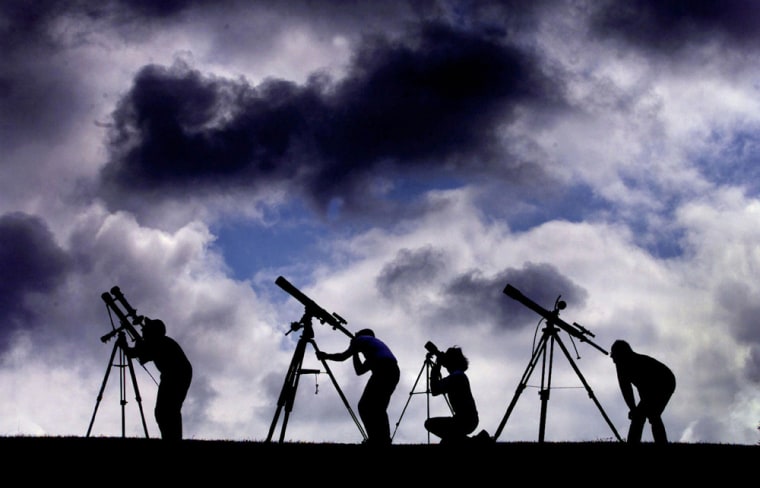As we approach the holiday season, many people may consider the purchase of a telescope. You might already have seen telescope ads in newspapers, catalogs or on TV shopping channels. A typical ad might say something like this:
"Bring the mysteries of the universe up close for your inspection. Study the sun, the moon, the planets, stars, comets and much, much more with this practical learning tool!"
Such claims are a seductive lure to the astronomy neophyte or the well-meaning parent or grandparent wishing to get their prospective space-minded children an instrument with which they can "discover the wonders of the heavens."
But sadly, while most of these "department-store" telescopes may seem like a good deal, they usually end up causing complete frustration. Important considerations:
Be wary of power
One of the things that is usually promised is incredibly high power. Be aware that virtually any telescope can provide you with, say, 500-power magnification. Yet in most cases, such an advertised magnification is well beyond the practical maximum magnification of the telescope.
The result: big, blurry images.
A 2.4-inch refracting telescope, for example, should never use more than 120-power (the rule of thumb is 50-power per inch of aperture). In fact, for such a telescope, the most rewarding views will probably come using one-half of the practical maximum magnification (60-power).
Look for stability
Another common problem is the telescope mounting, which for most "off-the-shelf" instruments is usually lightweight and unstable. Such mountings are, in turn, attached to a wobbly tripod. A telescope can have the finest optics in the world, yet can be rendered totally useless if the mount is so poor that the image can’t be held in place.
But of course, the uninitiated (usually that "space-minded child") will want to "test-drive" the telescope at the highest possible magnification. The result will be an enlarged and hopelessly fuzzy image that will be virtually impossible to keep in the telescope’s field of view thanks to its defective and unbalanced design.
Before you know it, that "practical learning tool" has ended up in the back of a closet or up in the attic, never to be seen again!
More tips
If you still have your heart set on purchasing a telescope, here are a few good tips to follow:
- Go to your local bookstore or newsstand and browse through one of the various astronomy magazines where well-known and reputable manufacturers advertise astronomical telescopes.
- Many planetariums across the country offer courses on "How to Use a Telescope." Such classes typically assist both the prospective purchaser and those who wish to get the most out of an instrument that they already have.
- Contact local astronomical societies and attend star parties and other, similar events where you can look through various telescopes and talk to their experienced owners. Such gatherings are ideal "showrooms" for commercial as well as home-built telescopes.
Try this
I’m about to make a suggestion that most prospective telescope buyers — especially those neophytes of astronomy — do not want to hear: Consider the merits of binoculars before moving up to a telescope.
Some might think binoculars are a bit of a comedown from a telescope, but the fact is that for certain aspects of sky watching they are the best instrument.
Binocular vision provides our central image processing system (the brain) with confirmation of what both of our eyes are seeing. In effect we improve our signal-to-noise ratio by using two eyes. The brain filters out the random impulses from each eye and leaves us with a better view of the real object. The result is increased contrast (about 40 percent) and the ability to see fainter objects.
A good pair of binoculars makes a very good instrument for the beginning sky watcher. As to what type of binoculars you should purchase, that’s sort of like asking, "What breed of dog should I buy?" Everybody has his or her personal favorites.
Binocular tips
Most preferable for stargazing are the 7x50 "night-glasses," although my own personal preference is a pair of 7x35 binoculars that give a much wider than normal field of view. The first number states the power of the binocular (7-power), while the second number represents the diameter of the objective lens in millimeters (35 or 50).
Find a reputable store that carries a good range of binoculars, and get a knowledgeable salesperson who can talk you through all the pros and cons of the different models. Insist that you be allowed to look through five or six pairs across the range of prices. A lot is going to depend on what feels right to you: binoculars that fit comfortably in your hand and across your eyes, that have controls in the right places, and seem to offer a good balance between economy and performance.
Easy to use and relatively inexpensive, binoculars are helpful in learning the constellations and in getting acquainted with many attractive deep-sky objects.
And when held steadily (though you can also mount them on a tripod) they’ll give you a glimpse of the craters of the moon, the crescent of Venus and the moons of Jupiter. Should a bright comet come along, there is no better instrument to give you a great overall view of both the head and tail. And by sweeping along the Milky Way, you’ll be treated to a myriad of stars. Because they don’t give an inverted view (as is the case with most telescopes), binoculars are especially convenient for comparing a sky map with the stars themselves.
And since binoculars require an absolute minimum set-up and takedown time, a frigidly cold winter’s night won’t deter you from enjoying even a brief session outside.
Last, but certainly not least, the practical experience binoculars give will enable any beginner to get much more satisfaction when they’re finally ready to purchase their first telescope.
